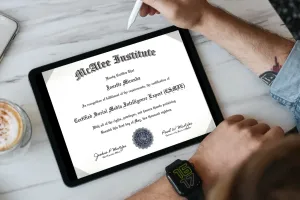Why Open-Source Intelligence is the Foundation of Modern Investigations
A basic osint course teaches you to gather and analyze publicly available information from the internet, social media, and public records to conduct effective investigations. These courses cover search techniques, social media intelligence, image analysis, geolocation, essential tools, and ethical considerations, preparing you for roles in intelligence, law enforcement, and corporate security.
What You'll Find in a Quality Basic OSINT Course:
- Search Engine Mastery – Google Dorking and advanced query operators
- Social Media Intelligence (SOCMINT) – Analyzing profiles, connections, and digital footprints
- Image Intelligence (IMINT) – Reverse image searching and metadata extraction
- Geolocation Techniques (GEOINT) – Pinpointing physical locations from digital clues
- Operational Security (OPSEC) – Protecting your identity during investigations
- Documentation & Reporting – Creating admissible evidence and professional reports
Open-Source Intelligence (OSINT) is the backbone of modern investigations. Whether tracking financial fraud, conducting background checks, or analyzing cyber threats, the ability to extract actionable intelligence from public data is essential. As one industry expert puts it: "The Internet is a powerful and practically endless source of information, and fraud examiners should be utilizing it as a resource in every investigation."
The challenge isn't just finding information—it's knowing where to look, how to verify it, and what legal boundaries to respect. Structured training provides the foundational framework to transform raw data into intelligence. You'll learn the intelligence cycle—planning, collection, processing, analysis, and dissemination—the same methodology used by federal agencies and corporate security teams worldwide.
I'm Joshua McAfee, and I've built my career on empowering investigators with practical, government-recognized training. My basic osint course curricula have trained thousands of professionals, giving them the skills and credentials needed for specialized investigative roles.

What Core Skills Will You Learn in a Basic OSINT Course?
This section covers the fundamental techniques and tools that form the curriculum of any quality introductory OSINT program.
Foundational Investigative Techniques
Think of OSINT as detective work for the digital age. A basic osint course teaches a systematic approach to uncovering information that most people miss. You'll learn to take a single piece of data—like an email address or username—and strategically pivot from it to build a comprehensive intelligence picture, changing isolated data points into actionable insights.
Google Dorking is where many investigations begin. This technique uses advanced search operators to turn Google into a precision instrument, allowing you to craft laser-focused queries that uncover hidden or specific information.

Social Media Intelligence (SOCMINT) opens up a vast investigative avenue. Platforms like Twitter, Facebook, and LinkedIn are digital gold mines. You'll learn to analyze profiles, trace connections, examine posts, and even uncover deleted content. A good course teaches you how to steer each platform's unique potential.
Image Intelligence (IMINT) proves a picture is worth a thousand words. Through reverse image searching, you can find a photo's origin and other instances across the web. The real power comes from metadata analysis, particularly EXIF data, which can contain the camera model, time, and even GPS coordinates. You'll also learn to identify physical locations by analyzing visual clues within images.
Geolocation (GEOINT) techniques let you pinpoint locations using digital breadcrumbs. By piecing together context clues from images, videos, or social media posts, you can reveal geographical locations with surprising accuracy.
The distinction between passive and active reconnaissance is crucial. Passive reconnaissance involves gathering information without directly interacting with a target, keeping you invisible. Active reconnaissance involves direct interaction and carries a higher risk of detection. Understanding this difference is fundamental to operational security.
These foundational skills transform raw data into intelligence, as we explore in our Understanding OSINT: A Comprehensive Guide.
Essential Tools and Platforms
Techniques are your foundation, but tools are your force multipliers. A quality basic osint course puts essential tools in your hands through practical application.
Hunchly is a go-to solution for capturing and organizing web data, automatically documenting your browsing sessions to preserve critical evidence and maintain a chain of custody.
Maltego helps you visualize relationships between data points, revealing connections that might otherwise remain hidden. Many introductory courses will give you a taste of its capabilities.
Shodan is a specialized search engine for internet-connected devices, from security cameras to industrial control systems, opening up new investigative possibilities.
Beyond specialized software, you'll master the investigative potential of everyday platforms. Search engines like Google and Bing have unique capabilities. Social media platforms offer native search functions that reveal powerful insights. Public records databases provide access to government and commercial information about individuals and businesses.
The OSINT Framework serves as a comprehensive, web-based collection of OSINT tools and resources, organized by category. It's an invaluable starting point for any investigation.
The Importance of OPSEC and Documentation
Protecting yourself is as important as finding information. Operational Security (OPSEC) isn't paranoia—it's professional practice.
Virtual Private Networks (VPNs) mask your IP address, while Virtual machines (VMs) create isolated environments for your work, preventing cross-contamination with your personal computer.
Sock puppets—fictitious online personas—allow you to conduct investigations without revealing your true identity. Creating and managing these effectively requires skill and ethical awareness, which any reputable course will emphasize.
Documentation makes or breaks an investigation. Note-taking must be meticulous, and report writing must transform your findings into clear, professional documents. Evidence preservation means capturing digital artifacts in a forensically sound manner. Tools like Hunchly can automate much of this, but understanding the principles is key to ensuring your evidence maintains its integrity.
For more advanced applications of these techniques, check out 5 Incredible OSINT Techniques to Supercharge Your Investigations in 2025.
How to Choose the Right Basic OSINT Course
Not all OSINT training is created equal. With options ranging from free tutorials to comprehensive certification programs, it's easy to feel overwhelmed. The right basic osint course can launch your career, while the wrong one may leave you with surface-level knowledge.
Let's walk through the key factors that separate exceptional training from the mediocre.
Hands-On Labs and Practical Application
You can't learn OSINT just by reading; you need to get your hands dirty. The best courses don't just lecture—they put you in the investigator's seat.
Look for programs that include capstone projects and real-world scenarios that challenge you to tackle a realistic investigation from start to finish. These aren't just academic exercises—they're the kinds of investigations you'll conduct in your career. Effective training often uses gamified learning platforms or challenge-based labs to make practice both engaging and effective. When evaluating a course, ask about the amount of lab time and the types of practical exercises you'll complete. Demand a program that emphasizes hands-on experience with cutting-edge tools.
To explore hands-on training options, check out McAfee Institute's OSINT Labs and Practical Training.

Instructor Expertise and Course Support
Learning from someone who's actually done the work makes all the difference. When an instructor can say, "Here's what happened when I used this technique on a real fraud case," the lesson sticks.
Look for instructors with genuine real-world experience—people who've worked in law enforcement, intelligence agencies, or corporate investigative roles. Law enforcement and intelligence community practitioners bring a unique perspective, as they understand the stakes and real-world constraints you'll face. That's not just marketing speak—it's a fundamental difference in quality.
But expertise alone isn't enough. You also need live instructor support—someone you can ask when you're stuck. Don't underestimate the value of community access either. Learning alongside peers creates opportunities for collaboration and support. At McAfee Institute, we provide lifetime access to both instructors and our learning community, so you're never left to figure things out alone.
Accreditation and Professional Certification
Here's where the rubber meets the road: you want a credential that opens doors, not just expensive wallpaper. Government-recognized and employer-trusted certifications carry real weight in the industry.
When McAfee Institute certifications are accredited by multiple U.S. government agencies, that's a signal to hiring managers that you've met rigorous standards. These credentials are respected across law enforcement, intelligence, and corporate security sectors because they represent proven competence.
If you already hold professional certifications, look for courses that offer Continuing Professional Education (CPE) credits. This allows you to learn new skills while maintaining your existing credentials—that's efficiency.
Also consider whether a basic course serves as a pathway to advanced certifications. A solid foundational course should prepare you for the next step in your professional development. Recognized credentials are a significant factor in career advancement.
If you're wondering why these credentials matter so much, we've laid out the case in detail: 10 Reasons Why OSINT Certifications Are Essential for Your Career. And when you're ready to explore accredited programs that deliver real career impact, take a look at McAfee Institute Board Certifications.
The Ethical Compass: Navigating Legal Boundaries in OSINT
Every OSINT investigation walks a line between powerful capability and potential overreach. A quality basic osint course doesn't just teach how to find informationit teaches when and how ethically to use these techniques. This is about maintaining professional integrity and ensuring your work stands up to scrutiny.

Think of ethics and legality as the invisible boundaries of your investigative playground. Just because you can find something doesn't always mean you should collect it or that you can legally use it. Understanding these boundaries protects you, your organization, and the credibility of your investigations.
Privacy laws like Europe's GDPR and California's CCPA vary dramatically by region and set different standards for data collection. A solid training program will explicitly cover these privacy laws to help you steer this complex landscape. You need to know not just what's publicly available, but what you're legally permitted to collect and use.
The concept of admissible evidence is crucial if your findings might end up in court. If you collect information improperly, it could be worthless or even jeopardize an entire case. Proper chain of custody and meticulous documentation are what transform your findings into actionable intelligence.
Remember the distinction between passive and active reconnaissance? There's a technical difference and an ethical one. Passively collecting public information is generally safe. But active techniqueslike interacting with targets or using sock puppetsenter a grey area that demands careful thought and often legal guidance. Reputable courses emphasize investigator safety, recognizing that some techniques carry risks.
Ethical data collection goes beyond legality. Just because something is public doesn't make it ethical to collect in every context. Is it proportionate to your investigation's scope? Does it respect human dignity? A good course instills an ethical framework to help you develop the judgment to make these calls.
OSINT explicitly does not involve illegal hacking, unauthorized system access, or any form of intrusion. The line between legitimate OSINT and illegal cyber activity is bright and clear. Crossing it doesn't just risk your career; it can lead to criminal charges.
Professional bodies, like the Association of Certified Fraud Examiners, regularly highlight that the field is constantly evolving. This means we need continuous awareness and ongoing education to ensure our methods remain both effective and responsible.
For deeper insights into maintaining ethical standards while using cutting-edge techniques, explore Five High-Value OSINT Techniques with AI Investigators Probably Haven't Thought Of (And How to Use Them Ethically). This kind of continuous learning ensures our work remains not just powerful, but principled.
From Beginner to Professional: Career Paths and Prerequisites
The demand for OSINT skills is skyrocketing, making a basic osint course a fantastic entry point into numerous exciting career paths. But what do you need to get started, and where can these skills take you?
What are the prerequisites for a basic OSINT course?
Here's the good news: the entry barrier for a basic osint course is refreshingly low. You don't need a computer science degree or years of technical experience to get started.
Curiosity is perhaps the most important trait. If you have a genuine desire to dig deeper and connect seemingly unrelated dots, you're already halfway there. As many instructors say, they can teach you the tech—you just need to bring the curiosity.
An analytical mindset is equally valuable. OSINT isn't just about finding information; it's about identifying patterns and drawing logical conclusions. If you enjoy solving puzzles, you'll thrive in OSINT work.
Basic computer literacy is the only technical prerequisite for most entry-level programs. If you're comfortable using an internet browser and managing files, you have the foundation you need. A keen interest in digging for information online is all it takes to get started.
Since much of the OSINT world operates in English, proficiency in the language is also beneficial. Many programs welcome professionals from non-traditional academic backgrounds who are ready to learn a new skill set.
Here's what you don't need: advanced technical skills. A true basic osint course starts with the fundamentals, assuming little to no prior technical knowledge. If you're eager to learn how to find information online like a professional investigator, you're ready to start your OSINT journey.
Career Opportunities with OSINT Skills
The applications of OSINT are incredibly diverse, which makes these skills so valuable. Learning OSINT doesn't just add a line to your resume—it opens doors to entirely new career paths.
Intelligence Analysts work for government agencies, military organizations, or private firms, gathering OSINT to provide strategic insights that inform critical decisions.
Cybersecurity Analysts use OSINT for threat intelligence, identifying vulnerabilities, tracking threat actors, and enhancing an organization's defensive posture. This includes roles like SOC Analysts and Digital Forensics and Incident Response (DFIR) professionals.
Fraud Examiners employ OSINT to uncover financial fraud and conduct due diligence. The Association of Certified Fraud Examiners (ACFE) specifically trains its members in these techniques because they are essential to modern fraud investigation.
Law Enforcement Officers integrate OSINT into criminal investigations to locate suspects, gather digital evidence, and conduct background checks. These skills have become mainstream in modern policing.
Corporate Investigators and Due Diligence Analysts perform background checks, conduct competitive intelligence, and manage corporate reputation. HR departments increasingly rely on OSINT to vet potential candidates.
Journalists and Researchers use OSINT to verify facts, uncover stories, and conduct in-depth research—skills that are critical in today's information landscape.
Threat Hunters proactively search for cyber threats and vulnerabilities using OSINT techniques, working to stay ahead of attackers.
OSINT Investigators work in dedicated roles focused on conducting investigations across various domains, from insurance fraud to missing persons cases.
Learning OSINT means you're investing in a future-proof capability that is increasingly vital across nearly every industry. Whether you're looking to advance in your current field or pivot to a new career, OSINT training provides the foundation for high-impact, meaningful work.
Frequently Asked Questions about OSINT Training
When people first consider taking a basic osint course, certain questions come up again and again. Let's walk through the most common ones to help clarify what you can expect from your OSINT training journey.
What is the difference between basic and advanced OSINT?
Think of it this way: basic OSINT is like learning to drive on familiar streets, while advanced OSINT is navigating complex highways with specialized equipment.
A basic osint course focuses on the fundamentals. You'll learn to use standard search engines effectively (including Google Dorking), analyze social media profiles, access public records, and maintain operational security. The goal is to teach you how to start investigating and show you what's possible with readily accessible tools.
Advanced OSINT pushes these fundamentals further. It introduces more complex techniques like navigating the dark web, using data scraping and automation with scripting languages like Python, and correlating large datasets to build complex intelligence pictures. Advanced training often requires more technical proficiency and specialized software. You don't need to jump straight to advanced; master the basics first, and you'll have a solid foundation for everything that comes next.
How long does a typical basic OSINT course take to complete?
The duration varies, which means there's an option for nearly every schedule and learning style.
Self-paced online courses can range from 5 to 15 hours of content, perfect for completing over a weekend or a few evenings. Intensive bootcamps compress the learning into a few days of immersive, instructor-led training. Longer certificate programs can span several weeks or months, requiring a set number of study hours per week.
When evaluating courses, look at the total hours of content, not just the number of days. At McAfee Institute, our courses offer lifetime access, so you can work through the material at your own pace without pressure—a valuable benefit if you're balancing training with a full-time job.
Can I learn OSINT for free?
Yes, and that's one of the ironies of Open-Source Intelligence—many learning resources are open, too. You can find a wealth of free blogs, articles, and video tutorials online. These are a great way to gauge your interest in the field.
However, professionals serious about career advancement typically invest in a paid, structured basic osint course. A comprehensive curriculum ensures you cover all foundational topics systematically. Hands-on labs provide invaluable experience that free resources rarely offer. Live instructor support means you can get guidance from experts when you hit a roadblock.
Perhaps most importantly, a recognized certification validates your skills for employers. McAfee Institute's government-recognized certifications, for example, are highly respected within law enforcement, intelligence, and corporate sectors. They signal to employers that you've completed rigorous, standardized training—not just watched a few online videos.
Finally, reputable paid courses stay current. OSINT techniques and tools evolve rapidly. With McAfee Institute, you get free updates for life, ensuring your knowledge never becomes outdated. While free resources are a good starting point, a quality certified course provides a more robust and career-enhancing experience.
Conclusion
Taking a basic osint course is more than just learning a new skill—it's opening the door to a career where your curiosity and analytical abilities can make a real difference. Whether you're drawn to intelligence work, fraud examination, or cybersecurity, these foundational skills give you the tools to uncover hidden connections and build compelling cases from public data.
We've explored what makes a quality OSINT program: practical, hands-on labs, experienced instructors from the field, and recognized certifications that employers value. These three elements—practical application, expert guidance, and professional credentials—are what separate courses that merely inform from those that transform your capabilities.
Equally important is how you use these skills. Operating within legal and ethical boundaries ensures your work holds up under scrutiny and maintains your professional integrity. The best investigators aren't just technically proficient; they're trusted because they do things the right way.
At McAfee Institute, we've built our reputation on providing government-accredited programs that combine rigorous training with lifetime access and ongoing support. Our programs are designed by professionals who've served in law enforcement and intelligence roles—people who understand what you'll face in the field. This isn't theoretical training; it's practical knowledge that translates directly into career advancement and leadership opportunities.
Investing in proper training is an investment in your future. The demand for OSINT professionals continues to grow, and having a recognized certification can be the difference between being considered for a position and being passed over.
Ready to begin your journey? Explore Basic OSINT Board Certifications and find how government-recognized training can launch your career in digital investigation.






Member discussion